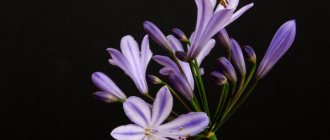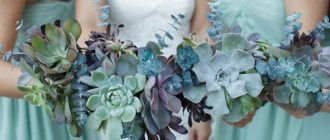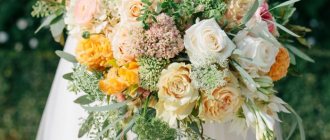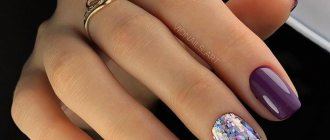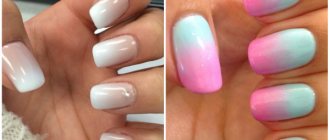Rules for making bouquets
To ensure that the flowers in the composition do not conflict with each other, it is necessary to follow several rules for selecting components:
- To create a complete composition, use no more than 3 varieties of plants and some greenery.
- Do not overload the bouquet with different numbers of shades. They must harmonize and complement each other.
- When collecting a composition, it is better not to use flowers that negatively affect the “neighbors”. These are lilies of the valley, lilies, orchids, carnations, they are usually used in mono-bouquets.
- The sizes of flowers depend on the specifics of the composition. So, in small bouquets you should not use many large buds. But voluminous bouquets will not be harmonious if they are dominated by plants with small inflorescences.
How to make a good bouquet?
A correctly selected arrangement of flowers in a beautiful package will be an excellent gift for anyone. However, to create a truly beautiful and unusual bouquet, it will not be enough to simply see a photo and the name of the flowers for the bouquets, then choose the option you like and purchase it in the store. A novice florist should know which flowers go together and which ones are best not combined in one bouquet. It is also necessary to know various techniques and methods for connecting buds to each other. What can we say about all sorts of accessories, which are often very difficult to attach to a bouquet.
However, such a task seems incredibly difficult only at first glance. If you look into the details in more detail, it turns out that what a florist needs is patience and creativity. It is also recommended to know about the hidden meanings of each flower, since some of them are suitable for wedding celebrations, others for an anniversary gift, and others for a declaration of love. In addition, the color palette should be bright and harmonious, but achieving a good combination can be difficult.
Algorithm for making a bouquet
When composing a bouquet, experienced florists recommend following a certain algorithm of actions in order to make fewer mistakes in the process. For example, if you first prepare the flowers, and only then begin to determine the shape, then you may end up with extra buds that you will simply have to throw away.
- We decide what the future composition will look like.
- Choose a suitable shape that matches the size of the bouquet.
- We select a good color scheme that harmonizes with the packaging.
- We decide on the number of flowers of each color and type.
- We prepare flowers using a knife or pruning shears.
It is worth noting that it is best to cut flowers at an angle of 45°, and then immediately place them in water. If you are making flowers for a store, then the cut must be regularly updated so that the flower can absorb water. With such manipulations, the compositions will last much longer.
Contrasting palette
This is one of the traditional and effective ways of combining flowers in bouquet arrangements. The combination of opposite colors creates the necessary brightness and charges with energy. True, the contrast should be natural, not sharp. For example, florists often use combinations of blue and orange, green and yellow. Very bright shades can create a variegated effect, so using pastel contrasting colors (light purple and sky blue, for example) is a great option.
Another option is a combination of a light shade with a dark shade opposite it in the palette (light green and dark yellow) - this allows you to create very harmonious compositions.
Plants for bouquets: from the most popular to exotic
Almost any plant in the world can be used to create a beautiful and harmonious composition. But most often, florists use the same sets of flowers that they use for bouquets due to their popularity and versatility.
Roses
Roses are the most common type of flower for bouquets on the planet. They will be an ideal option for almost any holiday, and also if you do not know the preferences of the person to whom you want to give flowers. Roses are used by almost all florists in the world, but few people know about the significance of this type of flower for bouquets:
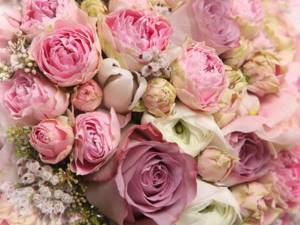
- red roses represent passion and love;
- white - purity, tenderness and mystery;
- yellow – joy and boundless happiness;
- cream – constancy, harmony, perfection.
If you don’t know what color of roses to give as a gift, then it is strongly recommended to focus on the meaning of the flowers, since some people always look for hidden meaning in gifts. It will be quite awkward if you give red roses to someone for whom you do not have loving feelings.
It is also impossible not to say that roses combine harmoniously with almost any type of flower. Among the most successful compositions: lavender, lilies, callas, lilacs, gypsophila, daffodils, lilies of the valley. Any material made in a calm tone is suitable for packaging.
What to combine roses with?
Lilies and alstroemeria are perfect for roses. Violets look very harmonious with white roses. It is also worth trying to combine roses with herbs, such as lavender. Some people believe that roses are independent flowers that should be given just like that. They attract a lot of attention, so other flowers in the bouquet should be more delicate and sophisticated.
Carnation
This flower is over two thousand years old and is deeply steeped in symbolism and mythology. It is believed that the name of the flower comes from the Latin word for “flesh”, which is why carnation is closely associated with the ritual of transformation and reincarnation. The most popular colors of carnations are red and pink, but they can also be found in shades of purple, blue and yellow.
Who can you give a summer bouquet to?
You can give a magnificent bright composition to a dear person: wife, girlfriend, sister, mother, friend.
Men can be given bouquets of dark shades; the design should be strict and laconic. An excellent option is a composition of blue irises, packed in craft paper.
A summer bouquet can be given for any occasion and just for no reason. Every woman will appreciate the beauty and naturalness of the seasonal composition.
You can give a summer bouquet to:
- for a birthday;
- anniversary;
- discharge from the maternity hospital;
- on a date;
- with no reason.
Simple recommendations will help you create and decorate a bright summer bouquet for any occasion. Remember that flowers are the smile of the sun, which gives joy and good mood!
Exotic and rare flowers
Not all bush flowers for bouquets, the colorful photos and names of which we reviewed above, can surprise a fastidious lady or an artsy gentleman. Rare flower arrangements from the following options are more suitable for them:
- Gloriosa is an exotic beauty for unusual and bright solutions.
- Amaranth is an amazing plant with hanging inflorescences.
- Brassica is an unusual flower for wedding arrangements and holiday decorations.
- Celosia - similar in texture to carnations, often complements other plants in voluminous and lush compositions.
- The spherical craspedia will certainly become the central flower in the autumn and winter composition.
- Tillandsia xerographica is a rare flower that looks like a jellyfish. Its curling grayish long leaves look great in vintage bouquets.
- Echeveria - goes well with dahlias, often used to create winter bouquets with eucalyptus and dried flowers.
- Astilbe is a romantic ornamental plant with elongated, fluffy and lush inflorescences.
Rare garden and wildflowers will undoubtedly enchant and leave a lot of pleasant emotions and impressions. With proper care, they last in a vase for a long time.
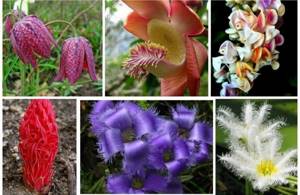
Combination of tulips with other flowers in a bouquet
Tulips are associated with spring, tenderness, and romance. Therefore, in a bouquet they should look natural and relaxed. It is not recommended to combine these flowers with plants on hard stems. A single, lush branch of mimosa or chrysanthemum can highlight the elegance of tulips. Tulips with sophisticated alstroemerias look decent. Since the plant is large, you should not decorate the bouquet with bulky ribbons and other decorative elements. An original composition will be obtained by combining tulips with “cockerels”. A bouquet of tulips and bells will be an ideal gift for your girlfriend on March 8 or Valentine's Day.
Original color combinations
Florists are increasingly using blue, violet and cyan flowers when creating their creations, which are suitable for a bouquet for both men and women; we will consider their names and photos below:
- Spathiphyllums are small decorative flowers that are most often given in baskets.
- Scylla or Scilla are fragrant spring primroses that look like blue snowdrops.
- Liverworts or coppices are spring flowers of bright blue color, they are arranged in a basket or in a large leaf with lilies of the valley or other small primroses.
- Mouse hyacinths or Muscari are small flowers for combined and mono-bouquets, radiating warmth and tenderness.
- Freesias are one of the most original flowers, embodying fragile charm and sophisticated aristocracy.
- Lily of the valley - most often found in nature in white, but there are blue and pale purple varieties.
- Lilac - a classic sprig of this spring flower is sure to become a focal point among smaller plants or an ideal complement in combination with tulips or peonies.
- Crocuses - these voluminous and bright primroses are a symbol of cheerfulness and the onset of the first days of spring.
- Clematis is a climbing ornamental plant with small blue flowers, which are often used to decorate floral arrangements for the bride.
- Veronica - small flowers, similar to a spike, have different colors, from dark blue to pale blue.
- Cornflowers - shy and simple flowers - are an ideal solution for creating a voluminous field bouquet.
Of course, this is not the entire list of colors that have purple, blue and blue tints. Breeders have long bred hybrid varieties of roses, hydrangeas, chrysanthemums, orchids, forget-me-nots, and delphiniums, which will emit their “heavenly” color next to soft pink, yellow or red flowers, live sprigs of berries or ornamental grasses.
What flowers can you use to make a summer bouquet?
Summer compositions can be made from any plants that bloom at this time of year. Florists use wild, meadow and garden flowers of various shapes and sizes. A summer bouquet must contain decorative greenery (fern, asparagus, etc.), which emphasizes the brightness and richness of the floral ensemble.
Top 10 Popular Summer Flowers
Among the wide variety of flora that is used to make summer bouquets, some flowers stand out from the rest.
The most common flowers for making a summer bouquet:
- Refined irises are very popular in all countries of the world. Flowers come in purple, milky, burgundy and yellow shades.
- Charming daisies. Garden, field and large decorative varieties are used to make bouquets.
- Magnificent gerberas are rich in a variety of colors.
- Light anemones look like poppies with a velvet center. In nature there are red, blue and cream flowers.
- Hydrangeas look like small fluffy balls of openwork flowers.
- Delicate eustomas resemble roses, but without thorns.
- Fluffy asters boast a variety of shades.
- Delphiniums look like a shaggy spike. The most common flowers are blue, white and red.
- Ranunculus look graceful and elegant, similar to peonies.
- Cornflowers attract with their delicate terry petals.
The composition, collected from summer plants, is distinguished by its naturalness and special charm, and will certainly appeal to even the most sophisticated connoisseur of beauty.
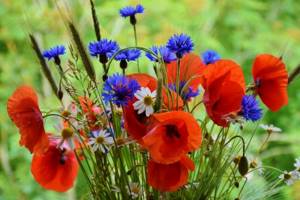
Bouquet for a young girl - video
Sources
- https://nasotke.ru/nazvaniya-cvetov-dlya-buketov.html
- https://sadovnikam.ru/442721a-tsvetyi-dlya-buketov-foto-i-nazvanie-opisanie-pravila-sostavleniya-buketov-i-znachenie-tsvetov
- https://glav-dacha.ru/cvety-dlya-buketov-foto-i-nazvaniya/
- https://FB.ru/post/nature/2017/2/9/10033
- https://lafoy.ru/samye-krasivye-cvety-v-mire-654
- https://tsvety-bukety.ru/raznovidnosti-tsvetov-dlya-buketov
The combination of chrysanthemums with flowering and foliage plants
Chrysanthemum is another popular representative of decorative flora. The flower is rich and voluminous, so it is often placed in the central part of the bouquet. It is recommended to combine chrysanthemums with:
- delicate delphiniums;
- sparkling irises;
- fragrant lilies;
- lush limonium.
In a composition of chrysanthemums, there should be few other colors so that they do not draw attention to themselves. To make the combination of chrysanthemum with lily or iris look harmonious, florists recommend making stems of different lengths. You can complement the bouquet with sprigs of fern or asparagus. You need to collect a bouquet with love, and then it will definitely bring a lot of positive emotions to the owner. Don't be afraid to experiment!
